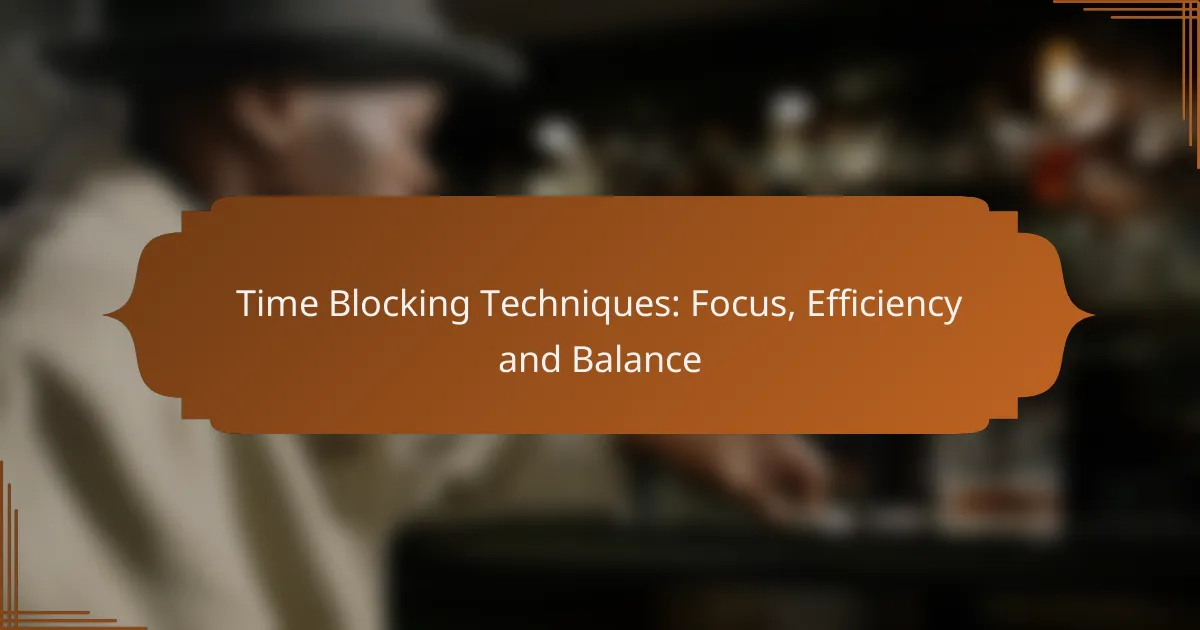Time blocking techniques are powerful strategies for managing your time effectively by designating specific periods for focused work on tasks. By minimizing multitasking and distractions, these methods not only enhance productivity but also foster a balanced approach to both work and personal life. Utilizing tools like Trello, Todoist, and Google Calendar can further streamline your time blocking efforts, helping you stay organized and on track.

What Are Effective Time Blocking Techniques?
Effective time blocking techniques help individuals manage their time by allocating specific periods for focused work on tasks. These methods enhance productivity, reduce distractions, and promote a balanced approach to work and personal life.
Pomodoro Technique
The Pomodoro Technique involves working in short, focused bursts of typically 25 minutes, followed by a 5-minute break. This method encourages sustained concentration while preventing burnout through regular intervals of rest.
To implement this technique, set a timer for 25 minutes and commit to working on a single task until the timer goes off. After four cycles, take a longer break of 15-30 minutes to recharge.
Time Chunking
Time chunking divides your day into larger blocks dedicated to specific types of tasks, such as administrative work, creative projects, or meetings. This approach allows for deeper focus and minimizes the cognitive load of switching between different activities.
For example, you might allocate two hours in the morning for creative work and another hour in the afternoon for emails and calls. Ensure that each chunk is long enough to make significant progress without interruptions.
Task Batching
Task batching groups similar tasks together to streamline workflow and reduce transition time. By handling similar activities in one go, you can maintain focus and efficiency.
For instance, batch all your email responses into one session rather than sporadically throughout the day. This can save time and mental energy, allowing you to concentrate on more demanding tasks afterward.
Daily Time Blocking
Daily time blocking involves scheduling your entire day in advance, assigning specific time slots to different tasks and activities. This method provides a clear roadmap for your day, helping to prioritize tasks and allocate time effectively.
To practice daily time blocking, create a schedule each morning or the night before, outlining what you’ll work on during each hour. Be realistic about how much you can accomplish to avoid overloading your schedule.
Weekly Planning
Weekly planning is a broader approach that allows you to set goals and allocate time for various tasks over the course of the week. This technique helps you visualize your commitments and adjust priorities as needed.
At the start of each week, review your tasks and deadlines, then block out time for each major project. Consider using a planner or digital calendar to keep track of your weekly goals and ensure you stay on target.

How Does Time Blocking Improve Focus?
Time blocking enhances focus by allocating specific periods for tasks, minimizing multitasking and interruptions. This structured approach helps individuals dedicate their attention to one activity at a time, leading to improved productivity and clarity.
Reduces Distractions
Time blocking significantly reduces distractions by creating a clear schedule that delineates work periods from breaks. When you know exactly when you will be working on a task, you can prepare mentally and eliminate potential interruptions during that time.
For example, if you block out two hours for focused work, you can turn off notifications and inform colleagues that you are unavailable. This proactive approach helps maintain a distraction-free environment, allowing for deeper engagement with the task at hand.
Enhances Concentration
By dedicating specific time slots to individual tasks, time blocking enhances concentration and fosters a deeper level of engagement. This method encourages a single-task focus, which is often more effective than trying to juggle multiple responsibilities simultaneously.
Consider using techniques like the Pomodoro Technique within your time blocks, where you work for 25 minutes followed by a 5-minute break. This can help sustain your concentration over longer periods while preventing burnout.

What Tools Can Help with Time Blocking?
Several tools can enhance your time blocking efforts by helping you organize tasks, set schedules, and track progress. Popular options include Trello, Todoist, and Google Calendar, each offering unique features to support your productivity goals.
Trello
Trello is a visual project management tool that uses boards, lists, and cards to help you organize tasks. You can create a board specifically for time blocking, where each list represents a day or a time block, and each card contains tasks to complete within that block.
To effectively use Trello for time blocking, consider color-coding cards by priority or category. This allows for quick visual cues on what needs attention. Regularly review and adjust your boards to reflect completed tasks and shifting priorities.
Todoist
Todoist is a task management app that allows you to create tasks, set deadlines, and categorize them into projects. For time blocking, you can schedule tasks for specific time slots, ensuring that you allocate dedicated focus periods for each task.
Utilize the recurring task feature for regular commitments, and set reminders to keep you on track. A common pitfall is overloading your daily tasks; aim for a realistic number of tasks to maintain productivity without feeling overwhelmed.
Google Calendar
Google Calendar is a versatile scheduling tool that can be used for time blocking by creating dedicated events for each task or project. You can easily visualize your day, week, or month, ensuring that you allocate time effectively across various responsibilities.
To maximize its effectiveness, color-code your events based on categories, such as work, personal, or meetings. Be mindful of buffer times between blocks to accommodate unexpected interruptions, which can help maintain your overall schedule without stress.

How to Implement Time Blocking in Daily Life?
Implementing time blocking in daily life involves scheduling specific blocks of time for various tasks or activities. This technique enhances focus, efficiency, and balance by allocating dedicated time slots for priorities, reducing distractions, and improving productivity.
Identify Priorities
Identifying priorities is crucial for effective time blocking. Start by listing tasks based on their urgency and importance, using methods like the Eisenhower Matrix to categorize them. Focus on high-impact activities that align with your goals and values.
Consider using a simple ranking system to determine which tasks deserve your attention first. This will help you allocate your time more effectively and ensure that you are working on what truly matters.
Set Specific Goals
Setting specific goals provides clarity and direction for your time blocks. Break down larger objectives into smaller, actionable tasks that can be completed within a single time slot. This makes it easier to track progress and stay motivated.
For instance, instead of a vague goal like “work on project,” specify “write 500 words for project report.” Clear goals help maintain focus and make it easier to assess your achievements at the end of each day.
Allocate Time Slots
Allocating time slots involves assigning specific periods for each task based on your priorities and goals. Use a calendar or planner to block out these times, ensuring you leave some buffer space for unexpected interruptions or breaks.
A common approach is to use the Pomodoro Technique, where you work for 25 minutes followed by a 5-minute break. This method can enhance concentration and prevent burnout, making your time blocks more effective.

What Are the Benefits of Time Blocking?
Time blocking offers several advantages, including enhanced focus, improved efficiency, and a better work-life balance. By allocating specific time slots for tasks, individuals can minimize distractions and manage their schedules more effectively.
Increased Productivity
Time blocking can significantly boost productivity by allowing individuals to concentrate on one task at a time. This method reduces multitasking, which often leads to decreased efficiency and increased errors.
To implement time blocking effectively, start by identifying your most important tasks and allocating dedicated time slots for each. For example, you might reserve mornings for deep work and afternoons for meetings and emails.
Better Work-Life Balance
By clearly defining work hours and personal time, time blocking helps create a healthier work-life balance. This structure encourages individuals to prioritize personal commitments and leisure activities alongside professional responsibilities.
To achieve this balance, set aside specific blocks for family time, exercise, or hobbies. For instance, you could schedule an hour each evening for family dinner or weekend activities, ensuring these moments are protected from work interruptions.
Improved Time Management
Time blocking enhances time management skills by providing a visual representation of how time is allocated throughout the day. This clarity helps individuals identify time-wasting activities and adjust their schedules accordingly.
To refine your time management, regularly review your time blocks and adjust them based on productivity levels. Consider using digital tools or planners that allow for easy adjustments and tracking of your time usage, ensuring you stay aligned with your goals.

What Challenges Might You Face with Time Blocking?
Time blocking can lead to several challenges that may hinder its effectiveness, including over-scheduling and flexibility issues. Understanding these potential pitfalls is essential for successful implementation.
Over-scheduling
Over-scheduling occurs when too many tasks are crammed into a limited time frame, leading to stress and decreased productivity. It’s crucial to realistically assess how much you can accomplish in a given period.
A good rule of thumb is to allocate about 50-70% of your available time for tasks, leaving the rest for breaks and unexpected interruptions. For example, if you have a 6-hour workday, aim to schedule 3 to 4 hours of focused work.
Flexibility Issues
Flexibility issues arise when rigid time blocks prevent you from adapting to changing circumstances or priorities. While structure is beneficial, being too strict can lead to frustration and missed opportunities.
To mitigate this, consider using buffer times between blocks to accommodate overruns or spontaneous tasks. For instance, if you plan a 2-hour block for a project, include a 15-minute buffer afterward to reassess or adjust your schedule as needed.
